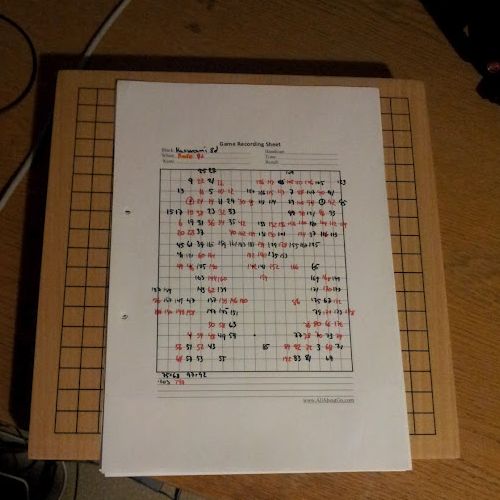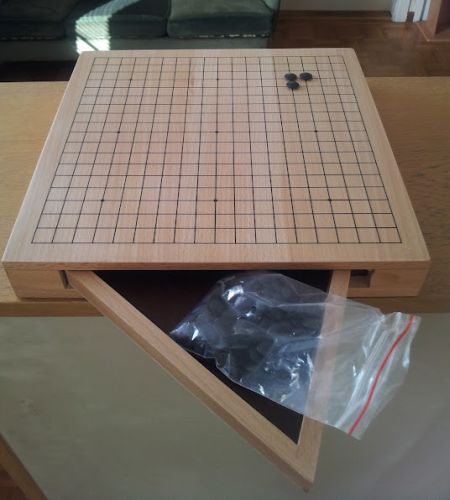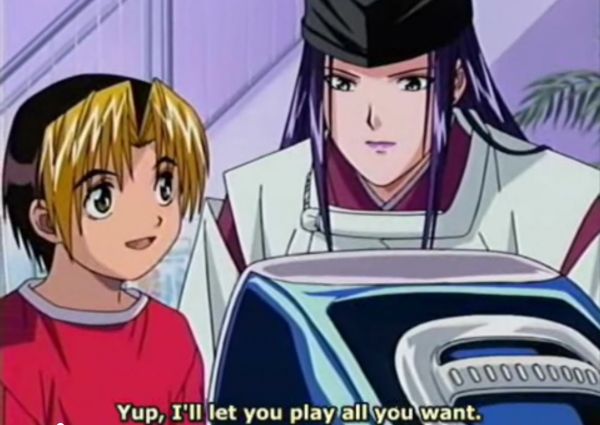
Felt tip coloring pencils are not ideal for writing game records, but they will do in a pinch, at least for short games.
Today’s newbie Go player report is from the mysterious land of “kifu”. The word means a record or map of the game. It is usually drawn on a simple picture of a Go board. On each intersection you write the number of the move. The first move is number 1, the second move is number 2 etc, and you write them on the map where they were played on the board. That way you can easily reconstruct the game later. Seasoned players can even read the game directly from a kifu as if they had watched it, more or less. I am not one of those. Definitely not.
Do you need a kifu? Not if you are just playing for fun. You can play the game and forget about it. Well, you may want to reflect on particularly stupid moves so as to not do those in the future, or on particularly clever moves of the opponent if you can figure them out. But apart from that, it is all water under the bridge.
But if you are studying Go, and want to get better, there are two obvious uses for kifu. You can record your own games so you can reflect on them at your leisure later. Or you can use kifu from better players to replay their games. This is one of the time-proven methods of getting stronger at Go. Even young professionals do it, so I hear. I am definitely not one of them, though. Still, I wanted to try it.
I did a Google search for “kifu paper”. There are a number of web sites which are eager to tell you to not use the phrase “kifu paper”. It is called “game record form” in English. But that is not a good search term as you will get lots of irrelevant hits. If you search for “kifu paper”, you come straight to the places where these sites tell you not to call it “kifu paper”, which happens to be right where you can download the form as well. ^_^
I picked the one from AllAboutGo.com, it was simple and to the point. Some have circles to write in, but I find it more natural to just write on the intersection. As recommended, I write the black moves in black (blue is fine also) and the white in red. It makes a big difference to how easy it is both to write and read. With this, you will not lose track easily or accidentally write 69 two times in a row. The black numbers are always odd, the red always even. Pure genius.
My first was an attempt to kifu an amateur match between a 9-dan and an 8-dan on the Internet Go Server. When you play yourself on the IGS, you can save a kifu that is made automatically, and download it at your leisure. It is possible you can do this with games you watch too, but the voices in my h… er, I thought it might be a good idea to write it by hand, involving other parts of the body and brain in the process.
I found out that fiber-tip coloring pens are not ideal for writing kifu. Who would have thought it? It worked, for the most part, up to 99. After that things became iffy.
Next out was coloring pencils. These worked well enough, although you may want to have a pencil sharpener around after a while. And who has pencil sharpeners in this age?
Eventually today I caved in and bought a red and a black Pilot V5 Hi-tecpoint 0.5. Because the quality of your Go obviously depends on the quality of your stuff. Well, to humans that may actually be true, since science has proven that people borrowing cheap imitations of brand sunglasses tend to cheat and not act with the dignity of those who borrow the real thing. So it is entirely possible that having an expensive Go board in real kaya wood, and writing your kifu with a quality fountain pen on original printed kifu forms will make you take your Go more seriously. But I like to think I am not like that. I am not saying I am not human (although sometimes I have wondered), but hopefully I am human in a different way than that. Still, a good pen is nice to have around. I haven’t had one in the Chaos Node for years.
So that’s my story. I am kifuing, as I call it, mainly to involve other parts of the body and brain, to improve subconscious learning. But is learning Go a good use of the sunset of your life? The Japanese certainly seem to think so, it is very popular among the elderly there. Millions of Japanese can’t be wrong! OK, they can – millions of Japanese were wrong during World War 2. But not about Go. In fact, if they had come to Pearl Harbor with Go boards, they would probably have won…
#go #igo #baduk #weiqi #kifu



